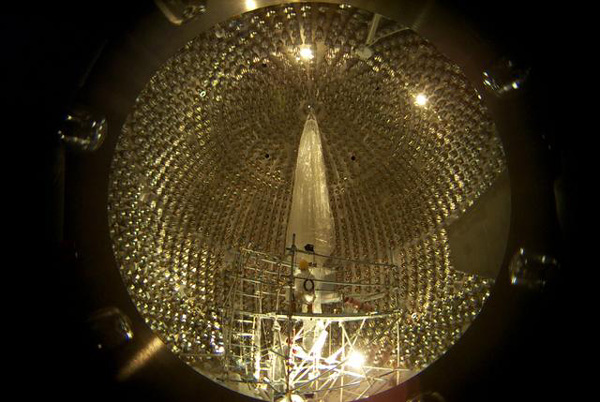
INSTITUTE FOR NUCLEAR THEORY
News
Home | Contact | Search | News archive | Site Map

|
INSTITUTE FOR NUCLEAR THEORY News
Home | Contact | Search | News archive | Site Map |
|||||
Solar Fusion Cross Sections for the pp Chain and CNO Cycle
The 21-23 January 2009 workshop brought together 42 participants - experimentalists
and theorists - to consider the nuclear microphysics important to the standard solar
model and to red giants. The workshop was highly international, reflecting the
important contributions being made by facilities like
Gran Sasso's LUNA and Japan's RIKEN.
The workshop was intended as an update to an earlier one, held in 1997. The
main purpose of the meeting was to critically evaluate the state of experimental
data important to key nuclear astrophysics cross sections, recommend "best
value" cross sections, estimate current uncertainties, and discuss future needs,
including new facilities that could speed progress. The organization was by
working groups, divided according to cross section or technique, and led by
designated discussion leaders (see Fig. 1).
The end product of this meeting will be a Reviews of Modern Physics article
updating the nuclear physics of the pp chain and CNO cycle. Prior to the
meeting each working group had identified key papers and archived these on the
workshop's web site. During the meeting these papers were reviewed and
discussed, and needed work identified. Work will continue off line, until
consensus is reached and the various chapters for the RMP article are written.
One motivation for holding the workshop now is the importance of precision
in interpreting current and future solar neutrino experiments. For example,
the 8B neutrino spectrum - the subject tackled by Working Group 4 - is
used in the interpretation of results from SNO and Super-Kamiokande.
Currently these collaborations employ slightly different spectra. Similarly, Borexino
is currently running (Fig. 2), and a deeper version of this
experiment, SNO+, is expected to be one of the first experiments mounted in SNOLab.
These experiments will check the MSW mechanism, which predicts
that the survival probability for low-energy neutrinos is greater than that of
the high-energy 8B neutrinos. They may be able to isolate the neutrino
flux from the Sun's weak CN cycle, which would in turn directly constrain the
metalicity of the Sun's core.
One of the questions where additional consensus was sought concerns
indirect methods for measuring S-factors. In the case of asymptotic normalization
coefficients, it was argued that in cases where elastic scattering
is measured to constrain optical potentials, and other checks are made
to demonstrate the reaction is
peripheral and 1-step (DWBA), then reliability at the level of 10% is achievable.
Continuum couplings destroy the relation between cross section and ANC, and have
been argued to be absent theoretically only in one case.
In the case of Coulomb dissociation, there was wide agreement that the GSI-2
results provide the best data set. Summerer showed that Descouvemont 2004
fits their data better than other parametrizations.
Because of ongoing discussions about model dependence in the comparison
of direct and indirect methods, the decision was made to analyze
direct and indirect data sets for reactions like 7Be(p,γ) separately, and
to rely on the direct data for the S17(0) recommendation.
The ERNA collaboration data on 3He+4He were presented: the preprint
was released just prior to the workshop. The new results disagree significantly with
older measurements made at high energy. One preliminary new
activation point measured at Madrid with the Weizmann apparatus seems to
confirm the high energy behavior seen by ERNA. At low energy the ERNA
results are in good agreement with Seattle group measurements, both
of which lie somewhat above Weizmann and LUNA measurements.
There was great interest in new underground facilities, given the marvelous
results obtained by LUNA for reactions like 14N(p,γ).
Figures
FIG. 1 The working group organization for the workshop.
FIG. 2 The Borexino detector, now operating in Gran Sasso.
(INT Workshop January 21 - 23, 2009)
Reported by W. Haxton
Date posted April 7, 2009
![]()
Working Group Working Group Leaders 1. S11 and Related Theory
Key PapersJiunn-Wei Chen, National Taiwan Univ.
Kuniharu Kubodera, Univ. South Carolina2. 3He+3He S-factor
Key PapersUwe Greife, Colorado School of Mines
Paolo Prati, INFN-Genova 3. p + 7Be and p+d S-factors
Key PapersGianluca Imbriani, Univ. Napoli
Michael Hass, Weizmann Institute4. Neutrino spectra
Key PapersStuart Freedman, Univ. California Berkeley
Alejandro Garcia, Univ. Washington5. 14N(p,γ) S-factor
Key PapersHeide Costantini, INFN-Genova
Hanns-Peter Trautvetter, Ruhr-U. Bochum 6. Other CNO S-factors
Key PapersPeter Parker, Yale Univ.
R. G. Hamish Robertson, Univ. Washington7. 3He+4He S-factor
Key PapersKurt Snover, Univ. Washington
Frank Strieder, Ruhr-U. Bochum8. hep S-factor
Key PapersLaura Marcucci, Univ. of Pisa
Tae-Sun Park, Sungkyunkwan Univ.9. 7Be, pep, CNO electron capture
Key PapersAndrei Gruzinov, New York Univ.
R. G. Hamish Robertson, Univ. Washington10. Theoretical issues
Key PapersWick Haxton, Univ. Washington
Stefan Typel, GSI11. Validating new techniques:
Trojan horse/Coulomb
dissociation/asymptotic
normalization
Key PapersEric Adelberger, Univ. Washington
Barry Davids, TRIUMF
Filomena Nunes, Michigan State Univ.12. Future facilities
Key PapersDaniela Leitner, Lawrence Berkeley Lab
Michael Wiescher, Notre Dame Univ.
